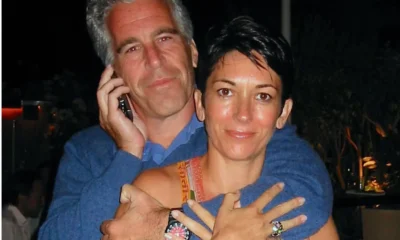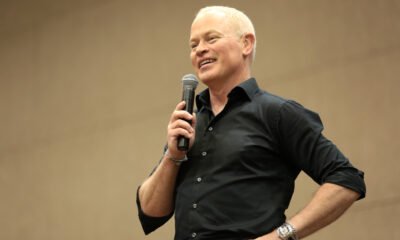Entertainment
Luann de Lesseps and Joe Bradley ‘All Over Each Other’ After … on January 26, 2024 at 4:20 pm The Hollywood Gossip
Did Countess Luann and Joe Bradley hook up in New York this week?
Even though The Real Housewives of New York City Season 14 was a polarizing success among many viewers, no one has forgotten the OGs.
This week, reports of RHONY alum Luann de Lesseps hooking up with Southern Hospitality star Joe Bradley took the internet by storm.
Is this a Bravolebrity match made in heaven (or at least BravoCon)? And did it involve cheating?
Real Housewives of New York City Star ‘Countess’ Luann de Lesseps as she appears on the season 11 reunion. (Image Credit: Bravo)
What did Luann de Lesseps and Joe Bradley get up to?
Eyewitnesses spoke to Us Weekly to report that Luann de Lesseps and Joe Bradley were making moves at New York’s Dream Hotel.
This alleged hookup went down on Wednesday night.
According to these snoops, the 58-year-old countess and the 28-year-old restaurant VIP manager were “all over each other.” Get it, girl!
Joe Bradley appears on Season 2 of Southern Hospitality. (Image Credit: Bravo)
Apparently, the sparks began flying during a professional interaction. It’s no coincidence that they’re both Bravolebrities.
According to the report, Luann and Joe were already “getting flirty” while filming an episode of Watch What Happens Live.
Later that night, they went to the venue, which is where eyewitnesses saw their alleged exchange of affection.
Watch What Happens Live aired on Thursday night, but taped the day before.
Here’s where things become complex: Joe is already in an entanglement with one of the Winter House cast, Danielle Olivera.
He actually discussed that romance on WWHL. And Danielle was in the audience — and Luann was in the chair next to Joe’s.
After seeing the episode, some viewers suspected that Danielle and Joe may have spent time apart after what Joe told Andy. Which may have given Luann her opening — allegedly.
Luann de Lesseps appears on season 10 of The Real Housewives of New York City. (Image Credit: Bravo)
Did Countess Luann and Joe Bradley actually hook up?
An inside source spoke to Page Six about Luann and Joe’s hookup report … and denied it.
“This is just a rumor,” the insider insisted, “and is not true.”
That is certainly interesting. Thus far, neither Luann nor Joe (or their respective reps) have put out any sort of statement, one way or the other.
On Season 2 of Southern Hospitality, Joe Bradley wears a white undershirt under a cobalt blue blazer. (Image Credit: Bravo)
What’s interesting here is that, denials or not, Joe met Danielle via BravoCon. The two hit it off in Vegas, made eyes at each other in the green room, and ended up boning on the last night of the event.
Since then, the two have managed to visit each other while carrying on a long-distance relationship.
However, this week, Joe did open up to Us Weekly about how he has been “pressing the brakes a little bit” to avoid official boyfriend/girlfriend labels.
In front of the Southern Hospitality confessional camera, Joe Bradley speaks his mind. (Image Credit: Bravo)
If Danielle was there in the audience, what happened?
Danielle lives in New York. Her appearing in the audience for WWHL was an obvious choice.
But it’s possible that Joe publicly speaking about “moving too fast” with her and hesitating to call her his girlfriend created a small rift. Perhaps enough for Joe to end up making eyes at a different Bravolebrity that night.
At least, that’s what some Bravo fans are suggesting in light of the report that they were packing on the PDA.
Luann De Lesseps wears pearls and a black halter top on the RHONY Reunion. (Image Credit: Bravo)
Again, we have no official word on whether Luann and Joe Bradley actually hooked up. Even with multiple eyewitnesses, maybe they were just … talking in a way that seemed cozy?
Luann has never given fans the impression that she’s shy about pursuing less-than-single men. That doesn’t mean that it happened with Joe.
But we may have to wait and hear it from Luann herself to see if she got her cougar on and pounced on the delectable Southern Hospitality star. Sometimes a rumor is just a rumor.
Luann de Lesseps and Joe Bradley ‘All Over Each Other’ After … was originally published on The Hollywood Gossip.
[[{“value”:”Did Countess Luann and Joe Bradley hook up in New York this week? Even though The Real Housewives of New …
Luann de Lesseps and Joe Bradley ‘All Over Each Other’ After … was originally published on The Hollywood Gossip.”}]]
The Hollywood Gossip Read More
Entertainment
What We Can Learn Inside 50 Cent’s Explosive Diddy Documentary: 5 Reasons You Should Watch

50 Cent’s new Netflix docuseries about Sean “Diddy” Combs is more than a headline-grabbing exposé; it is a meticulous breakdown of how power, celebrity, and silence can collide in the entertainment industry.
Across its episodes, the series traces Diddy’s rise, the allegations that followed him for years, and the shocking footage and testimonies now forcing a wider cultural reckoning.

1. It Chronicles Diddy’s Rise and Fall – And How Power Warps Reality
The docuseries follows Combs from hitmaker and business icon to a figure facing serious criminal conviction and public disgrace, mapping out decades of influence, branding, and behind-the-scenes behavior. Watching that arc shows how money, fame, and industry relationships can shield someone from scrutiny and delay accountability, even as disturbing accusations accumulate.

2. Never-Before-Seen Footage Shows How Narratives Are Managed
Exclusive footage of Diddy in private settings and in the tense days around his legal troubles reveals how carefully celebrity narratives are shaped, even in crisis.
Viewers can learn to question polished statements and recognize that what looks spontaneous in public is often the result of strategy, damage control, and legal calculation.
3. Survivors’ Stories Highlight Patterns of Abuse and Silence
Interviews with alleged victims, former staff, and industry insiders describe patterns of control, fear, and emotional or physical harm that were long whispered about but rarely aired in this detail. Their stories underline how difficult it is to speak out against a powerful figure, teaching viewers why many survivors delay disclosure and why consistent patterns across multiple accounts matter.
4. 50 Cent’s Approach Shows Storytelling as a Tool for Accountability
As executive producer, 50 Cent uses his reputation and platform to push a project that leans into uncomfortable truths rather than protecting industry relationships. The series demonstrates how documentary storytelling can challenge established power structures, elevate marginalized voices, and pressure institutions to respond when traditional systems have failed.
5. The Cultural Backlash Reveals How Society Handles Celebrity Accountability
Reactions to the doc—ranging from people calling it necessary and brave to others dismissing it as a vendetta or smear campaign—expose how emotionally invested audiences can be in defending or condemning a famous figure. Watching that debate unfold helps viewers see how fandom, nostalgia, and bias influence who is believed, and why conversations about “cancel culture” often mask deeper questions about justice and who is considered too powerful to fall.
Entertainment
South Park’s Christmas Episode Delivers the Antichrist

A new Christmas-themed episode of South Park is scheduled to air with a central plot in which Satan is depicted as preparing for the birth of an Antichrist figure. The premise extends a season-long narrative arc that has involved Satan, Donald Trump, and apocalyptic rhetoric, positioning this holiday episode as a culmination of those storylines rather than a stand‑alone concept.
Episode premise and season context
According to published synopses and entertainment coverage, the episode frames the Antichrist as part of a fictional storyline that blends religious symbolism with commentary on politics, media, and cultural fear. This follows earlier Season 28 episodes that introduced ideas about Trump fathering an Antichrist child and tech billionaire Peter Thiel obsessing over prophecy and end‑times narratives. The Christmas setting is presented as a contrast to the darker themes, reflecting the series’ pattern of pairing holiday imagery with controversial subject matter.
Public and political reactions
Coverage notes that some figures connected to Donald Trump’s political orbit have criticized the season’s portrayal of Trump and his allies, describing the show as relying on shock tactics rather than substantive critique. Commentators highlight that these objections are directed more at the depiction of real political figures and the show’s tone than at the specific theology of the Antichrist storyline.
At the time of reporting, there have not been widely reported, detailed statements from major religious leaders focused solely on this Christmas episode, though religion-focused criticism of South Park in general has a long history.
Media and cultural commentary
Entertainment outlets such as The Hollywood Reporter, Entertainment Weekly, Forbes, Slate, and USA Today describe the Antichrist arc as part of South Park’s ongoing use of Trump-era and tech-world politics as material for satire.
Viewer guidance and content advisory
South Park is rated TV‑MA and is intended for adult audiences due to strong language, explicit themes, and frequent use of religious and political satire. Viewers who are sensitive to depictions of Satan, the Antichrist, or parodies involving real political figures may find this episode particularly objectionable, while others may view it as consistent with the show’s long‑running approach to controversial topics. As with previous episodes, individual responses are likely to vary widely, and the episode is best understood as part of an ongoing satirical series rather than a factual or theological statement.
Entertainment
Sydney Sweeney Finally Confronts the Plastic Surgery Rumors

Sydney Sweeney has decided she is finished watching strangers on the internet treat her face like a forensic project. After years of side‑by‑side screenshots, “then vs now” TikToks, and long comment threads wondering what work she has supposedly had done, the actor is now addressing the plastic surgery rumors directly—and using them to say something larger about how women are looked at in Hollywood and online.

Growing Up on Camera vs. “Before and After” Culture
Sweeney points out that people are often mistaking normal changes for procedures: she grew up on camera, her roles now come with big‑budget glam teams, and her body has shifted as she has trained, aged, and worked nonstop. Yet every new red‑carpet photo gets folded into a narrative that assumes surgeons, not time, are responsible. Rather than walking through a checklist of what is “real,” she emphasizes how bizarre it is that internet detectives comb through pores, noses, and jawlines as if they are owed an explanation for every contour of a woman’s face.
The Real Problem Isn’t Her Face
By speaking up, Sweeney is redirecting the conversation away from her features and toward the culture that obsesses over them.
She argues that the real issue isn’t whether an actress has had work done, but why audiences feel so entitled to dissect her body as public property in the first place.
For her, the constant speculation is less about curiosity and more about control—another way to tell women what they should look like and punish them when they do not fit. In calling out that dynamic, Sweeney isn’t just defending herself; she is forcing fans and followers to ask why tearing apart someone else’s appearance has become such a popular form of entertainment.

 Entertainment2 weeks ago
Entertainment2 weeks agoWicked Sequel Disappoints Fans: Audience Verdict on For Good

 News4 weeks ago
News4 weeks agoYolanda Adams Questions Traditional Views on God’s Gender, Audience Reacts

 Entertainment2 weeks ago
Entertainment2 weeks agoAriana & Cynthia Say They’re in a ‘Non‑Demi Curious, Semi‑Binary’ Relationship… WTF Does That Even Mean?

 News3 weeks ago
News3 weeks agoEpstein Files to Be Declassified After Trump Order

 News4 weeks ago
News4 weeks agoTrump Throws Epstein Files at Clinton’s Door

 Entertainment4 weeks ago
Entertainment4 weeks agoAriana Grande’s Red Carpet: When Fans Forget Boundaries

 Entertainment4 weeks ago
Entertainment4 weeks agoHollywood’s Kiss or Miss Policy: Why Saying No Got Neal McDonough Blackballed

 Entertainment3 weeks ago
Entertainment3 weeks agoJimmy Cliff, Reggae Legend and Star of ‘The Harder They Come,’ Dies at 81


























